What’s a Guitar Saddle, and What’s its Role?
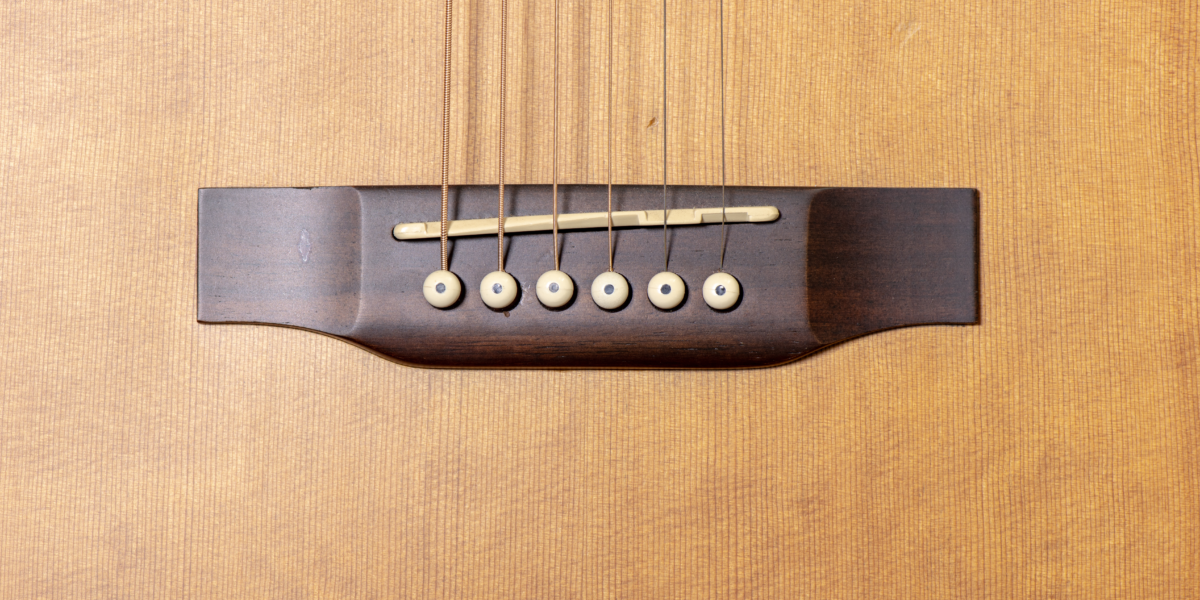
Learn everything there is to know about guitar saddles, including how to adjust the bridge saddle height and how you can replace it.
When you learn to play the guitar, you also need to become familiar with the parts of the guitar. It’s easy to see the role the strings, fretboard, and soundhole have as we strum the guitar. However, many other guitar parts affect the final sound.
The guitar saddle is a piece that is easy to overlook but has a significant role in your sound. It is only about two or three inches long and rests between the bridge and strings.
But what exactly does it do?
Let’s look at a guitar saddle’s role in guitar playing and how to adjust its height for the best sound.
What is a guitar saddle?
A guitar saddle is a small piece of bone, brass, or plastic that rests between the bridge and strings. It can transfer the vibration of the guitar strings to the soundboard. When you raise or lower the saddle, you can alter a guitar’s intonation to get a better pitch.
Why is it important?
A guitar saddle is so small it looks insignificant. However, this tiny plastic has an essential role in guitar playing.
The strings rest directly on the saddle. The saddle has the job of transferring tones from the guitar strings to the soundboard. You can bring pitches back in tune if the guitar saddle is too high or low.
If you want to change the height of your guitar saddle, you first need to know what kind of saddle you have.
The five main types of guitar saddles.
A guitar needs a saddle at the right height to sound its best. But, just as guitars come in many shapes, sizes, and styles, so do guitar saddles.
What type of saddle does your guitar have? Is it a drop-in, or is it glued to the bridge? Do you need to hire a luthier to do it?
Here are the five main saddles you usually see on a guitar.
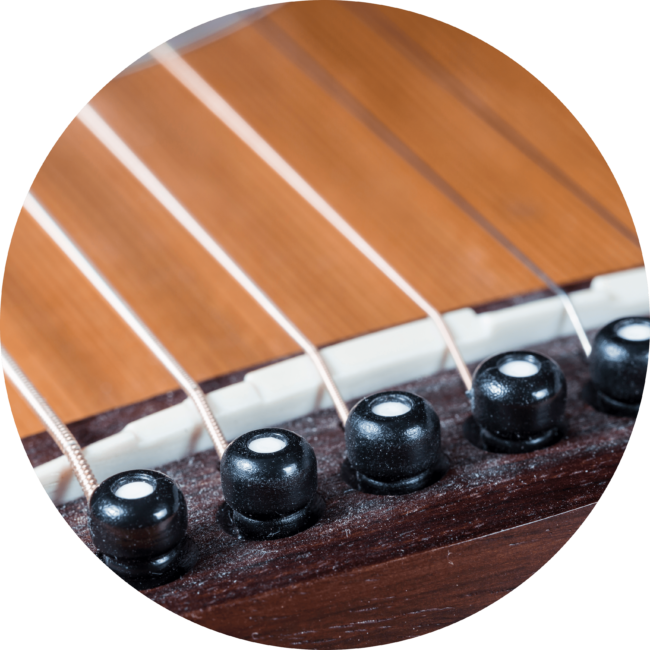
1. The compensated saddle
A compensated saddle is one of the most popular options for acoustic guitar. It has high points and low points molded into it. This shape allows the treble strings to rest higher and gives the low guitar strings a longer stretch. It adjusts the heights for bass and treble strings to keep the guitar’s intonation on the pitch.
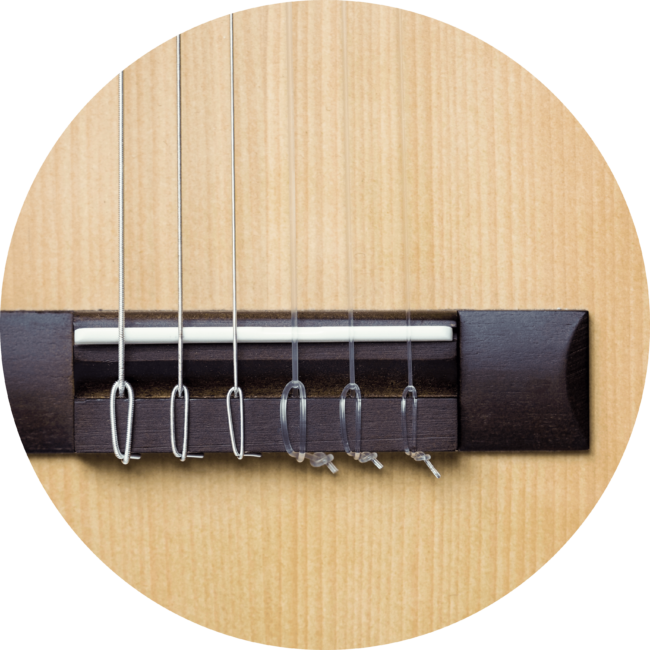
2. The straight, uncompensated saddle
The straight, uncompensated saddle is the “Plain Jane” of the different saddle types. It has no grooves or ridges. Instead, it is straight where the strings rest on it. Often, you find an uncompensated saddle on classical guitars with nylon strings. Nylon strings don’t need height compensation as much as metal strings do. They tend to hold intonation better, as well.
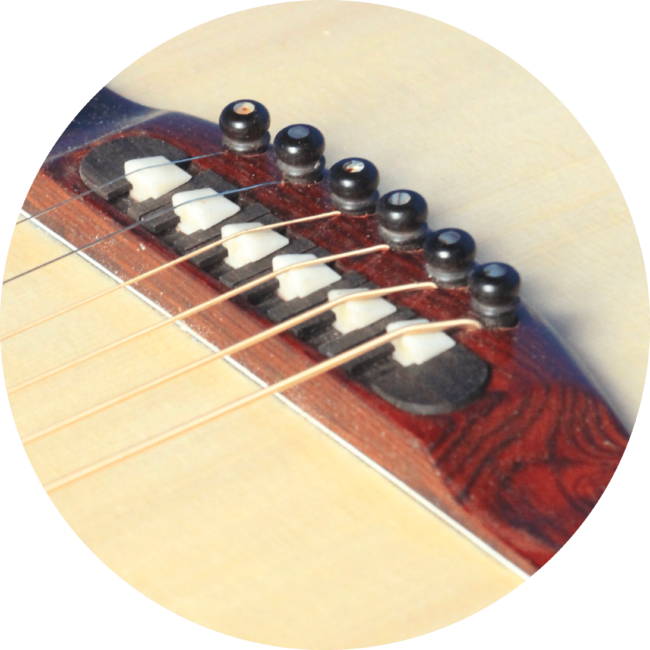
3. The adjustable, split saddle
Electric guitars often have adjustable saddles. While other saddles are one piece, the split saddle has six metal pieces that screw into the guitar bridge. Or, you may have three adjustable saddles that couple the strings into groups. This type of guitar saddle is one of the easiest to adjust. Simply tighten or loosen the screws with an Allen wrench to raise or lower the string height.
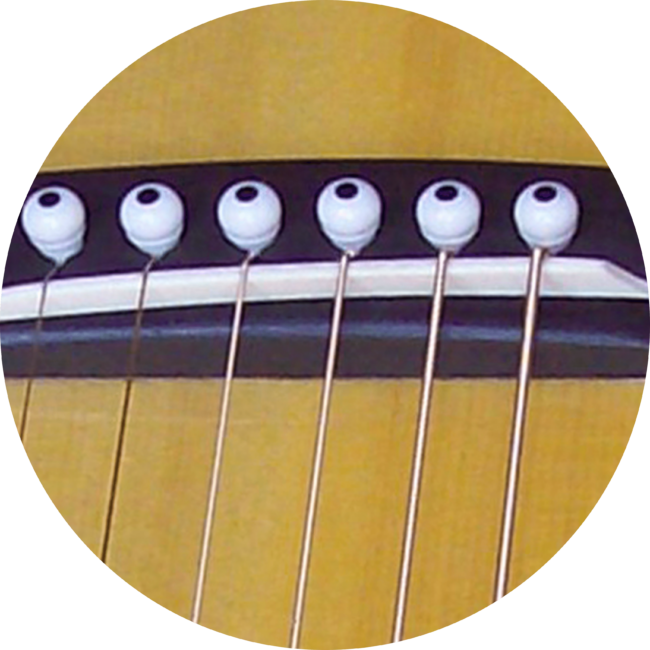
4. The drop-in saddle
Drop-in saddles are not attached to the guitar with glue or screws. Instead, drop-in saddles fit into a groove in the guitar bridge. This design makes it easy to change the angle or string height. You can also easily remove a drop-in saddle when you need to replace it. Many acoustic guitars use the drop-in saddle.
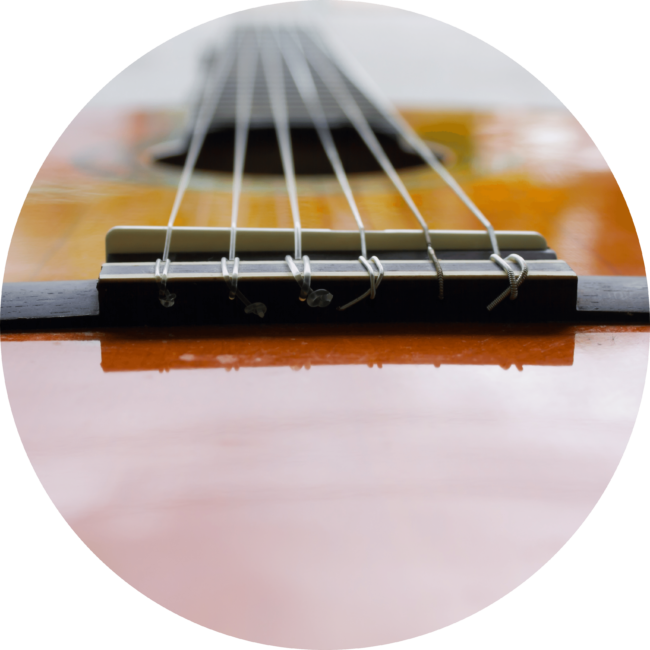
5. The long set saddle
Unlike the drop-in saddle, a set guitar saddle attaches to the guitar bridge with glue. To remove or adjust this saddle, apply heat until the glue softens. Without heat, the guitar saddle may break off in the groove when you try to remove it. However, if you apply too much heat, you can damage the finish on your guitar. When you need to replace a long set saddle, it may be a good time to call a luthier for help.
Guitar saddle vs. guitar bridge.
You often hear about the saddle and bridge as if they are the same thing. Indeed, you can’t have one without the other. However, these two guitar parts have different functions.
A bridge usually fits on the guitar body and holds the saddle and bridge pins. The strings cross the saddle and attach them.
The saddle rests on the bridge, and the strings rest on the saddle. Raising or lowering the saddle can affect the tone of your guitar. At the right height, a guitar saddle can reduce fret buzz and give your guitar the perfect intonation.
How to adjust the saddle height on a guitar.
As you strum out guitar pieces regularly, you may notice that your guitar keeps going out of tune. You may hear the strings buzzing against the frets, or the frets may be difficult to press down for a clear sound.
These issues indicate that you need to adjust the saddle height on your guitar. For techniques like slide guitar, you need to raise the saddle higher than usual to allow the guitar slide to move smoothly across the frets.
So, how do you raise or lower a saddle on a guitar?
Adjusting the saddle on an acoustic guitar
Adjusting the saddle on an acoustic guitar requires more precision than on an electric guitar. Before you start this in-depth project, you want to be sure that the saddle needs adjusting and that it’s not another part of the guitar at fault. The truss rod, nut slot depths, and the worn fret tops can also be responsible for string buzz.
Here are a few steps to follow to adjust the saddle on an acoustic guitar:
Mark the amount you want to remove.
By marking the saddle before you sand, you can be sure you don’t remove too much material. Even simply drawing a line in permanent marker on the bottom of the saddle can be a good idea. This mark lets you see how much saddle material you are shaving off at a time.
Indicate which side is treble and which is bass.
To put the saddle back in the correct position, subtly mark the treble and bass sides of the saddle. Then, when you put the piece back on the guitar, you know which direction it should face.
Use fine-grit sandpaper.
Place the saddle on a strip of fine grit sandpaper and rub it gently to lower the height.
Rub in one direction.
Make sure you push the saddle only in one direction. This way, you get more control over your strokes. You don’t want to shave off so much that this guitar part loses its purpose.
Apply even pressure.
Use even pressure as you sand the saddle to take off an equal amount of material on both sides. Then, make sure the bottom is flat. You don’t want a humpy base at the bottom of your guitar saddle.
Work in small increments.
In music, you don’t need to rush. (Unless you are playing a piece in Prestissimo.) Working slowly and checking your progress can give you the desired result.
When you are sanding down a guitar saddle, less is more.
Adjusting the saddle height for acoustic guitars can be a tedious project. However, changing the height of an electric guitar is much more straightforward.
Adjusting the saddle on electric guitars
Electric guitar saddles are generally the most accessible type of guitar to adjust. You don’t have to sand guitar parts or make permanent changes you may regret later. You don’t even have to remove the strings. Instead, each guitar saddle has two pins you can raise or lower using an Allen wrench.
Adjust both sides evenly, so the top of the saddle remains straight. You can check your work by seeing if the top of the saddle is level with the guitar top. Lopsided saddles are not what you want.
How to replace a bridge saddle on the guitar.
If your saddle is worn, you may need to replace it for a better height. Hiring someone to replace your saddle can cost up to $150. Doing it yourself can cost between $15 and $30, depending on the saddle you choose. Here are the steps you should follow.
1. Choose your saddle
Before you start working, you need to find a replacement saddle with the right characteristics. Check your existing guitar to see what type of saddle it uses. Then make your choice.
- Length–Choose a saddle that is slightly larger than you need. Then you can sand the edges to keep it even with the bridge.
- Thickness– Make sure your saddle fits your guitar in the right spot.
- Height– It’s a good idea to get a higher saddle than you need. You can always take off extra with sandpaper, but it’s hard to put it back.
- Material– Man-made ivory gives a great sound for acoustic and classical guitars. However, plastic is the most inexpensive version.
2. Remove the strings
To replace a saddle on an electric or acoustic guitar, you must remove the strings first. Then, you can reach the saddle and bridge.
3. Clean the guitar
Once the strings are off, take a moment to wipe down your guitar. Clean any grime from the frets. You can also rub some fretboard conditioner into the wood with a soft cloth.
4. Remove the saddle
Remove the saddle. If you have a set saddle, you need to unglue it using heat. However, drop-in saddles are easy to remove.
5. Replace the saddle
Once you remove the old saddle, it’s time to add a new saddle to your guitar. Generally, keep the bass strings lower and the treble strings higher for the best intonation.
6. Restring the guitar
Add new strings to your guitar, and then comes the moment of truth. How does the guitar sound now? Do you notice a difference in the tone?
Once you finish setting your guitar with the proper intonation, try out your skills for a crowd.
It can be cheaper to replace a guitar saddle on your own. But should you try it? If you are a beginning guitar student, it may be best to leave the job to an expert. This is especially true if your saddle is glued to the bridge. Better to be sure the job is done correctly than play the guitar with a poorly installed guitar saddle.
Final words.
As you learn to play the guitar, you master the guitar lingo and memorize the Parts of a Guitar. While saddle may only conjure up thoughts of horses, cowboys, and the wild west, now it has a new meaning. From now on, you can think of a tiny but significant part of the guitar.
To gain more guitar knowledge in quick soundbites, try out Simply Guitar. This friendly app gives you daily challenges and corrects your guitar songs in real-time.









